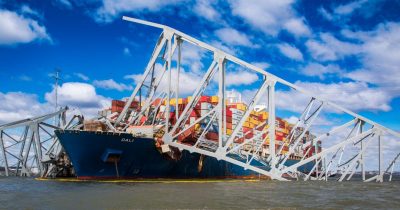The Francis Scott Key Bridge on the Patapsco River in Baltimore was the scene of a maritime accident after a vessel, Dali, rammed into the bridge more than two weeks ago. Three workers who went missing following the bridge collapse are still unaccounted for.
The U.S. Army Corps of Engineers (USACE) outlined a preliminary schedule to restore safe passage to and from the Port of Baltimore, with containers also moving off the wreckage so that shipping through the channel can commence.
Now, the National Transportation and Safety Board (NTSB) says they are focusing on Dali’s electrical system.
Investigations into the maritime accident
Over the weekend, US President Joe Biden visited the crash site.
The NTSB says that so far, no pollution has been reported. Initial damage estimates to the vessel and the bridge exceed $500,000.
In a briefing this week, the government agency’s chairperson, Jennifer Homendy, said: “We have had the manufacturer of equipment in the engine room to look closely at the electrical power system. We’re continuing to look at that. We’ve asked for additional assistance from the manufacturer, who returned from overseas this week with experts to look at the circuit breakers.”
Aftermath of the maritime disaster
New sonar images reveal the remains of Baltimore’s Francis Scott Key Bridge, now at the bottom of the Patapsco River. Captured by the U.S. Navy’s Naval Sea Systems Command, these images show the aftermath of the bridge’s collapse.
Looking at the bridge aftermath, the US Census Bureau says the bridge collapse could slow new home and business construction as delivery routes for supplies are disrupted.
US law firm Morgan Lewis says the disaster could become one of history’s costliest insured maritime events. “Businesses that depend on the impacted transportation infrastructure are facing significant financial losses,” says the firm.
Importance of the Port of Baltimore
The bureau highlights that the Port of Baltimore was the leading US port for imports of passenger vehicles ($22.4 billion), cane sugar ($410.6 million), and gypsum ($24 million).
As one of the oldest ports in the United States, it has a long history of serving the nation’s trade needs and has evolved over time to adapt to changing shipping technologies and trade patterns.
The Bureau of Transportation Statistics reports that the Port of Baltimore is among the top 20 ports in the United States regarding tonnage and the number of containers handled. The report adds that it is the 10th largest port for dry bulk and a major hub for importing and exporting motorized vehicles.
The port has specialized facilities for handling various cargo types, including automobiles, RORO cargo, containers, and bulk commodities. It’s particularly renowned for its handling of cars and RORO cargo.
Photo Credit: USACE (Facebook)
Share this article
About the author
Sharl is a qualified journalist. He has over 10 years’ experience in the media industry, including positions as an editor of a magazine and Business Editor of a daily newspaper. Sharl also has experience in logistics specifically operations, where he worked with global food aid organisations distributing food into Africa. Sharl enjoys writing business stories and human interest pieces.













